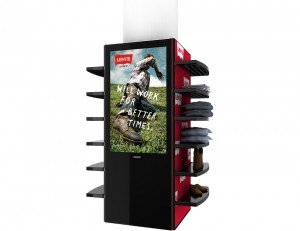How To Take Advantage of The Way Trade Show Attendees Are Feeling
We all wish that every trade show attendee who visited our exhibit was prepared with pen in hand to sign the deal. But that’s what we want. What about what they want?
How those attendees feel when they step off the aisle and into your exhibit has a major impact on the outcome of your interactions with them. But if you’re only thinking about getting them to act the way you want them to, you’re never going to be able to meet them where they are—emotionally—and deal with them on those terms.
There are many different emotions show attendees are feeling as they canvas a show floor and come upon your booth. Let’s deal with a few of the common mental states of booth visitors:
1. They’re Pressed For Time
There’s a lot to see and do on a show floor, and the people you’ll be dealing with have been busy throughout the day checking out other exhibitors, including your competitors. They’ve likely been hit with sales pitches all day long. Yours would just be another chorus of the same song—unless you can meet them where they are and harmonize your approach with their emotional tone.
When people are pressed for time, most salespeople would make the mistake of getting straight to the point—just the facts, ma’am—and going for the close. This would be a mistake, because it’s probably what your prospect has been hearing everywhere else.
To meet this prospect where he or she is emotionally, acknowledge the obvious. “I know you’re pressed for time and I’d like to help. What are your specific needs?” will get you further than “I know you’re pressed for time, so how about we give you ten percent off and we do the deal right now?”
The first approach shows your concern for his or her mental state, while also demonstrating you’re interested in what the prospect is looking for, not just pitching what you have to sell.
2. They’re experiencing sensory overload.
They’ve seen PowerPoint presentations, they’ve seen product demos, they’ve seen videos and they’ve seen lots of chattering salespeople. To separate yourself and your product or service from all the noise that’s preceded this prospect’s visit with you, you want to make a strong appeal to as many senses as possible.
Chances are your competitors have talked at your prospect while attempting to dazzle with visual stimuli. You’ll be better off if you try to get your prospect to feel what it would be like to have already purchased what you’re selling.
“Imagine what you’ll do with the time you save, when you can produce widgets 23% faster than before. How does that make your day more productive? Can you see your facility working at a faster clip? Can you hear your employees being more productive? Can you feel what it’s like to fill orders more quickly than you ever could before?”

RENTAL RE-2009 Arch Canopy, Halogen Arm Lights, RE-1202 Counter, (2) RE-1201 Counters, and Clear Acrylic Shelves. Tension Fabric Graphics, and Sintra Header and Counter Graphics
By appealing to their senses and speaking as though they’ve already purchased your product or service, you’re allowing them to experience a difference between now and then on many sensory levels.
3. They’re concerned about what’s going on at home, or back in the office.
Ideally, you want your prospect to be completely present with you while you’re trying to market your product or service. But that’s not always possible. And you know how that is.
When you’re at a show, you’re constantly thinking about pending business in your office, or your kid’s soccer championship that you had to miss to do this show. Whether you’re an exhibitor or an attendee, it’s hard to keep your mind on what’s happening in the booth.
Again, acknowledge the obvious, and build rapport by sharing your own situation. “I know it’s tough to be here and make decisions when there are things you’re concerned about at home and at the office. I had to miss my kid’s big game this week, and that’s tough. But if I can have just four minutes of your time, I’ll show you how you can automate your widget manufacturing and save 17% on your product costs. Can you give me four minutes?”
Then, keep your word. Hold your pitch to four minutes and move to close on a deal, or on a next step (a factory visit, a needs analysis, or anything that helps you wrap your hands around the sale).
4. They’re resistant to being sold.
They’ve been accosted by salespeople all day. If the same thing had happened to you, you’d be resistant, as well. So don’t approach them like you’re trying to sell to them. Make your first step one of relationship building. If you have an existing relationship with a booth visitor, you’re ahead of the game.
But if this prospect hasn’t been introduced to your company before, make that your objective—instead of being one more talky salesperson.
I’m not suggesting you attempt those trite common interest techniques taught in sales books (“Hey, are you a football fan? How did the Saints played last night, huh?”). Those approaches come across as shallow and false. Instead, meet your prospect where he or she is, and listen to their cues.
“Is your widget production cost rising? What have you tried to keep costs down? Can I share a few ways our clients are saving money? It won’t cost you anything, but four minutes of your time.”
Again, deliver on your promise. Share some cost-saving tips and keep it to four minutes or less. End with “If we can help you reduce widget production cost by an additional 17%, would you be interested?” If the prospect sticks around, you’re on your way to a sale. If not, you’ve laid the foundation stones of a relationship.
The way show attendees feel when they approach your exhibit is strongly affected by the look and feel of your exhibit itself. Does the booth you’re using now reflect your company and its products or services in their best light? If not, let us show you how we can help you create a more attractive display and close more sales. Call us at (425) 556-9511 or email [email protected].
For more, check out how to use surveys at trade shows and what to do if this is your first trade show.
[optin-monster-shortcode id=”kgycuhbazh-post”]
